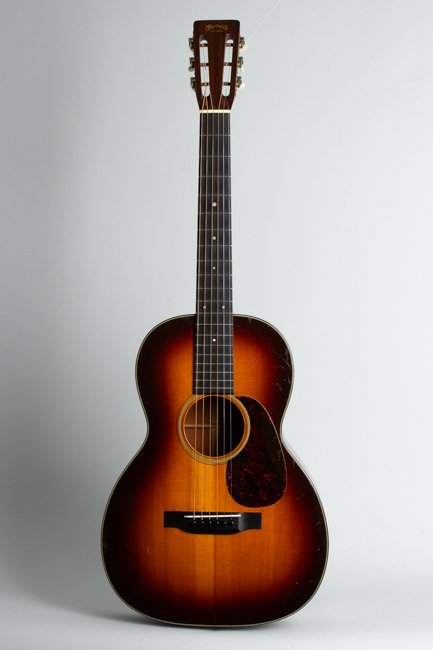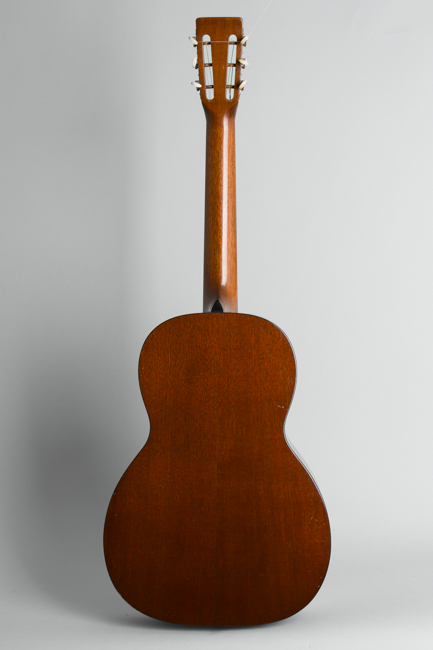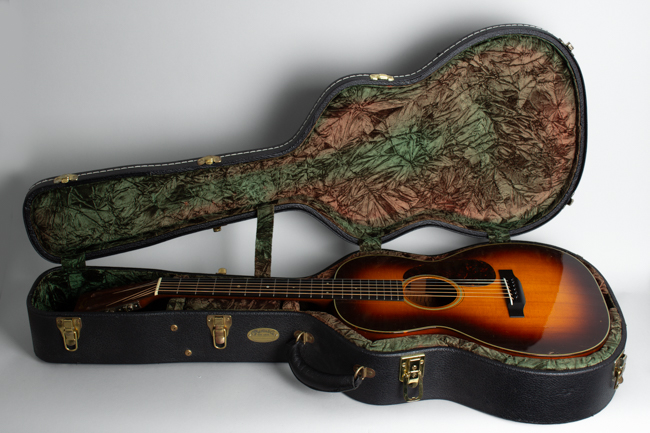C. F. Martin 00-18H Shade Top Conversion Flat Top Acoustic Guitar (1940)
C. F. Martin 00-18H Shade Top Conversion Model Flat Top Acoustic Guitar (1940), made in Nazareth, PA, serial # 74972, sunburst top, natural back and sides finish, mahogany back, sides and neck, spruce top and ebony fingerboard, black tolex hard shell case.
This lovely 1940 Martin is an interesting rarity, not only for its custom-ordered shaded top finish but also being one of the last pre-war 12 fret Hawaiian 00-18s to leave Nazareth. This guitar has had a superb professional conversion from the original Hawaiian mode including a neck reset, fretwork with Martin-style bar frets and a repro bridge with a properly angled saddle. The result is a superb playing and sounding instrument, a rare guitar with a distinct character.
The Hawaiian guitar was well on the march to electrification in 1940, so the market was fading for acoustic flat tops built specifically for lap players. This one dates to fairly early in the year, one of only 25 sold that year with a final 25 following in 1941. All of 255 00-18Hs were built in total, and most would have featured a natural top finish instead of the deep rich sunburst seen here. By this time the "regular" 00-18 was a 14-fret model, this Hawaiian variant was the only 12-fret version available.
The 00-18H is a fairly modest instrument, the only mahogany Hawaiian model in the company's mid-30's line priced well under the rosewood-and-pearl 00-40H at $40 (without case). It was primarily intended for students; teaching the Hawaiian guitar was still big business in the 1940s. Like all Style 18 models it is built with mahogany back and sides and a spruce top but maintaining the same workmanship standards as the highest-grade instruments.
The "Shaded" or "Dark" top catalog option for certain Martin models first appeared in the early 1930's. Originally a fairly subtle amber tone darkening around the edges, by the time this guitar was made the shading was deeper and bolder giving the whole top a darker look. This option was likely originally inspired by Martin customers and/or dealers and looking at Gibsons and wanting a similar look. Early 1940s catalog listings for the Style 18 noted "This style will be furnished with a shaded dark top instead of natural finish on request at no extra charge" but few were actually ordered.
Apart from the sunburst top the trim is simple with tortoise celluloid binding on the body, multiple W/B/W soundhole rings and graduated pearl dot inlay on the unbound ebony fingerboard. The guitar has "modern'' features like the belly bridge and tortoise celluloid pickguard not seen on 1920s 12-fret guitars. The tuners are older strip units with ivorioid buttons that look a bit old for this era; Martin was likely using up old stock on these now "outdated" slotted headstocks.
Martin's pre-war Hawaiian guitars were braced just slightly heavier than other models, but still scalloped to prewar standards. They tops are sturdier than their 1920's ancestors and of course designed for steel strings. They tend to have somewhat more punch than their 14-fret 1930s Spanish cousins when driven hard, but are still quite responsive. This is a great playing, super sharp-looking prewar Martin with a great vibe, very distinctive both visually and sonically.
Overall length is 38 1/2 in. (97.8 cm.), 14 1/4 in. (36.2 cm.) wide at lower bout, and 4 1/8 in. (10.5 cm.) in depth at side, taken at the end block. Scale length is 24 3/4 in. (629 mm.). Width of nut is 1 7/8 in. (48 mm.).
This 80+ year old 00-18H looks and sounds fabulous; it has seen a few notable repairs and but overall remains well preserved. The original lacquer finish shows some nicks and scratches over the top, back, and sides. On the top by the lower bout of the bass side there is a concentrated area of deeper nicks through the finish, most likely from "case bites" that are lightly touched up. Another old case bite a bit lower down the top has been touched up.
Below the bridge there are two old spruce grain splits hat run to the back edge, solidly glued with minimal touchup. There is also a repaired split running off of the top edge of the pickguard down to the bridge, fairly common for many older Martins. Other than these one more noticeable repair is located on the treble side below the heel, where a small puncture in the mahogany had caused a crack that runs down along the upper bout. This has been neatly repaired and touched up, with a small strip of mahogany patching up the hole. The heelblock was not affected by this impact.
Internally, all of the original scalloped braces are intact and unaltered. The bridge and bridgeplate have been professionally replaced with modern repros in the exact original style, with the saddle compensated for standard play. The conversion was very well done, and the fingerboard and bar frets remain in excellent shape. This distinctive Martin has a lovely sound, deep and punchy for a mahogany 00 sized guitar, quite responsive but more capable of forcing than many earlier 12-fret 00's. It is housed in a modern hardshell TKL case. Overall Excellent - Condition.
This lovely 1940 Martin is an interesting rarity, not only for its custom-ordered shaded top finish but also being one of the last pre-war 12 fret Hawaiian 00-18s to leave Nazareth. This guitar has had a superb professional conversion from the original Hawaiian mode including a neck reset, fretwork with Martin-style bar frets and a repro bridge with a properly angled saddle. The result is a superb playing and sounding instrument, a rare guitar with a distinct character.
The Hawaiian guitar was well on the march to electrification in 1940, so the market was fading for acoustic flat tops built specifically for lap players. This one dates to fairly early in the year, one of only 25 sold that year with a final 25 following in 1941. All of 255 00-18Hs were built in total, and most would have featured a natural top finish instead of the deep rich sunburst seen here. By this time the "regular" 00-18 was a 14-fret model, this Hawaiian variant was the only 12-fret version available.
The 00-18H is a fairly modest instrument, the only mahogany Hawaiian model in the company's mid-30's line priced well under the rosewood-and-pearl 00-40H at $40 (without case). It was primarily intended for students; teaching the Hawaiian guitar was still big business in the 1940s. Like all Style 18 models it is built with mahogany back and sides and a spruce top but maintaining the same workmanship standards as the highest-grade instruments.
The "Shaded" or "Dark" top catalog option for certain Martin models first appeared in the early 1930's. Originally a fairly subtle amber tone darkening around the edges, by the time this guitar was made the shading was deeper and bolder giving the whole top a darker look. This option was likely originally inspired by Martin customers and/or dealers and looking at Gibsons and wanting a similar look. Early 1940s catalog listings for the Style 18 noted "This style will be furnished with a shaded dark top instead of natural finish on request at no extra charge" but few were actually ordered.
Apart from the sunburst top the trim is simple with tortoise celluloid binding on the body, multiple W/B/W soundhole rings and graduated pearl dot inlay on the unbound ebony fingerboard. The guitar has "modern'' features like the belly bridge and tortoise celluloid pickguard not seen on 1920s 12-fret guitars. The tuners are older strip units with ivorioid buttons that look a bit old for this era; Martin was likely using up old stock on these now "outdated" slotted headstocks.
Martin's pre-war Hawaiian guitars were braced just slightly heavier than other models, but still scalloped to prewar standards. They tops are sturdier than their 1920's ancestors and of course designed for steel strings. They tend to have somewhat more punch than their 14-fret 1930s Spanish cousins when driven hard, but are still quite responsive. This is a great playing, super sharp-looking prewar Martin with a great vibe, very distinctive both visually and sonically.
Overall length is 38 1/2 in. (97.8 cm.), 14 1/4 in. (36.2 cm.) wide at lower bout, and 4 1/8 in. (10.5 cm.) in depth at side, taken at the end block. Scale length is 24 3/4 in. (629 mm.). Width of nut is 1 7/8 in. (48 mm.).
This 80+ year old 00-18H looks and sounds fabulous; it has seen a few notable repairs and but overall remains well preserved. The original lacquer finish shows some nicks and scratches over the top, back, and sides. On the top by the lower bout of the bass side there is a concentrated area of deeper nicks through the finish, most likely from "case bites" that are lightly touched up. Another old case bite a bit lower down the top has been touched up.
Below the bridge there are two old spruce grain splits hat run to the back edge, solidly glued with minimal touchup. There is also a repaired split running off of the top edge of the pickguard down to the bridge, fairly common for many older Martins. Other than these one more noticeable repair is located on the treble side below the heel, where a small puncture in the mahogany had caused a crack that runs down along the upper bout. This has been neatly repaired and touched up, with a small strip of mahogany patching up the hole. The heelblock was not affected by this impact.
Internally, all of the original scalloped braces are intact and unaltered. The bridge and bridgeplate have been professionally replaced with modern repros in the exact original style, with the saddle compensated for standard play. The conversion was very well done, and the fingerboard and bar frets remain in excellent shape. This distinctive Martin has a lovely sound, deep and punchy for a mahogany 00 sized guitar, quite responsive but more capable of forcing than many earlier 12-fret 00's. It is housed in a modern hardshell TKL case. Overall Excellent - Condition.












